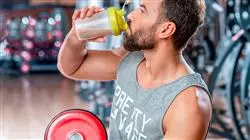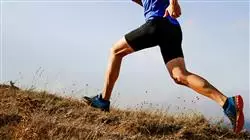University certificate
Scientific endorser

The world's largest faculty of medicine”
Introduction to the Program
Nutritional advice is essential in sports, as proper nutrition can help improve physical performance"

Elite athletes make a great physical effort during their daily activity, so it is normal that they may suffer certain injuries that require medical attention. However, nowadays, the popularization of physical exercise has meant that many people have incorporated sports practice into their daily tasks, taking it to a level of effort to which they are not used to and which, therefore, may also entail some physical risk. For this reason, specialization in sports nutrition goes beyond the knowledge of sports doctors, and should be seen as an essential complement for any health professional, who may find in their usual practice patients who, preventively or due to an injury, require advice in this field.
This has led to an increasing number of healthcare professionals looking for high quality Advanced master’s degree to improve their training in the field of nutritional counseling, which will allow them to offer more complete treatments that will facilitate their level of recovery. In this sense, TECH has decided to bet on this field, creating this Grand Master in Comprehensive Sports Nutrition, an Advanced master’s degree developed by a team of highly qualified teachers, which integrates the latest concepts in nutrition and sports.
Specifically, this program's syllabus provides a global vision of sports nutrition, while focusing on the most important and innovative aspects: Invisible training or proper diet for athletes, and nutrition before, during and after exercise. Additionally, it includes information related to professionals with different personal situations and different sports activities, specifying in each case the best dietary recommendations, with the objective that the Doctor has a complete knowledge that allows them to adapt to each user during the development of their daily practice.
Thus, this Advanced Master's Degree will become an indispensable study material for all physicians who wish to acquire the necessary qualifications to work safely in this field of practice.
Sports physicians will find in this Advanced Master's Degree a unique opportunity to improve in the field of nutritional counseling"
This Advanced master’s degree in Comprehensive Sports Nutrition contains the most complete and up-to-date scientific program on the market. The most important features include:
- The latest technology in e-learning software
- Intensely visual teaching system, supported by graphic and schematic contents that are easy to assimilate and understand
- Practical case studies presented by practising experts
- State-of-the-art interactive video systems
- Teaching supported by telepractice
- Continuous updating and recycling systems
- Self-regulated learning: full compatibility with other occupations
- Practical exercises for self-evaluation and learning verification
- Support groups and educational synergies: questions to the expert, debate and knowledge forums
- Communication with the teacher and individual reflection work
- Content that is accessible from any fixed or portable device with an Internet connection
- Supplementary documentation databases are permanently available, even after the program
Become an expert in nutritional counseling and offer a more personalized attention to athletes who come to your medical office"
The teaching staff for this program is composed of practicing professionals. This way, TECH can fulfill the objective of academic updating that it has set for itself. A multidisciplinary staff of experienced professionals from a variety of environments, who will develop theoretical knowledge in an efficient manner, but above all, will put at the service of the students, practical knowledge derived from their own experience.
This command of the subject is complemented by the effectiveness of the methodological design of this Grand Master. As such, it was developed by a multidisciplinary team of e-learning experts and integrates the latest advances in educational technology, allowing students to study with a range of convenient and versatile multimedia tools that will give them the operational skills they need for their training.
The design of this program is based on Problem-Based Learning, an approach that conceives learning as a highly practical process. To achieve this remotely, TECH will use telepractice. Thanks to an innovative interactive video system and learning from an expert, students will be able to acquire the knowledge as if they were facing the scenario they are currently learning. A concept that will allow students to integrate and memorize what they have learnt in a more realistic and permanent way.
In TECH you will be able to use an innovative teaching methodology that will be fundamental to facilitate learning"

Enroll in this Advanced master’s degree and have unlimited access to all the of the program resources"
Why study at TECH?
TECH is the world’s largest online university. With an impressive catalog of more than 14,000 university programs available in 11 languages, it is positioned as a leader in employability, with a 99% job placement rate. In addition, it relies on an enormous faculty of more than 6,000 professors of the highest international renown.

Study at the world's largest online university and guarantee your professional success. The future starts at TECH”
The world’s best online university according to FORBES
The prestigious Forbes magazine, specialized in business and finance, has highlighted TECH as “the world's best online university” This is what they have recently stated in an article in their digital edition in which they echo the success story of this institution, “thanks to the academic offer it provides, the selection of its teaching staff, and an innovative learning method aimed at educating the professionals of the future”
A revolutionary study method, a cutting-edge faculty and a practical focus: the key to TECH's success.
The most complete study plans on the university scene
TECH offers the most complete study plans on the university scene, with syllabuses that cover fundamental concepts and, at the same time, the main scientific advances in their specific scientific areas. In addition, these programs are continuously being updated to guarantee students the academic vanguard and the most in-demand professional skills. In this way, the university's qualifications provide its graduates with a significant advantage to propel their careers to success.
TECH offers the most comprehensive and intensive study plans on the current university scene.
A world-class teaching staff
TECH's teaching staff is made up of more than 6,000 professors with the highest international recognition. Professors, researchers and top executives of multinational companies, including Isaiah Covington, performance coach of the Boston Celtics; Magda Romanska, principal investigator at Harvard MetaLAB; Ignacio Wistumba, chairman of the department of translational molecular pathology at MD Anderson Cancer Center; and D.W. Pine, creative director of TIME magazine, among others.
Internationally renowned experts, specialized in different branches of Health, Technology, Communication and Business, form part of the TECH faculty.
A unique learning method
TECH is the first university to use Relearning in all its programs. It is the best online learning methodology, accredited with international teaching quality certifications, provided by prestigious educational agencies. In addition, this disruptive educational model is complemented with the “Case Method”, thereby setting up a unique online teaching strategy. Innovative teaching resources are also implemented, including detailed videos, infographics and interactive summaries.
TECH combines Relearning and the Case Method in all its university programs to guarantee excellent theoretical and practical learning, studying whenever and wherever you want.
The world's largest online university
TECH is the world’s largest online university. We are the largest educational institution, with the best and widest online educational catalog, one hundred percent online and covering the vast majority of areas of knowledge. We offer a large selection of our own degrees and accredited online undergraduate and postgraduate degrees. In total, more than 14,000 university degrees, in eleven different languages, make us the largest educational largest in the world.
TECH has the world's most extensive catalog of academic and official programs, available in more than 11 languages.
Google Premier Partner
The American technology giant has awarded TECH the Google Google Premier Partner badge. This award, which is only available to 3% of the world's companies, highlights the efficient, flexible and tailored experience that this university provides to students. The recognition as a Google Premier Partner not only accredits the maximum rigor, performance and investment in TECH's digital infrastructures, but also places this university as one of the world's leading technology companies.
Google has positioned TECH in the top 3% of the world's most important technology companies by awarding it its Google Premier Partner badge.
The official online university of the NBA
TECH is the official online university of the NBA. Thanks to our agreement with the biggest league in basketball, we offer our students exclusive university programs, as well as a wide variety of educational resources focused on the business of the league and other areas of the sports industry. Each program is made up of a uniquely designed syllabus and features exceptional guest hosts: professionals with a distinguished sports background who will offer their expertise on the most relevant topics.
TECH has been selected by the NBA, the world's top basketball league, as its official online university.
The top-rated university by its students
Students have positioned TECH as the world's top-rated university on the main review websites, with a highest rating of 4.9 out of 5, obtained from more than 1,000 reviews. These results consolidate TECH as the benchmark university institution at an international level, reflecting the excellence and positive impact of its educational model.” reflecting the excellence and positive impact of its educational model.”
TECH is the world’s top-rated university by its students.
Leaders in employability
TECH has managed to become the leading university in employability. 99% of its students obtain jobs in the academic field they have studied, within one year of completing any of the university's programs. A similar number achieve immediate career enhancement. All this thanks to a study methodology that bases its effectiveness on the acquisition of practical skills, which are absolutely necessary for professional development.
99% of TECH graduates find a job within a year of completing their studies.
Advanced Master's Degree in Comprehensive Sports Nutrition
Due to the energy expenditure that athletes face because of the high-performance training in which they participate, having a proper diet is essential to maintain their physical and health conditions in an optimal state. This makes that the assistance of competent professionals in the sports field becomes a necessity to guide the nutritional process of the patient, in addition to ensuring a high-quality experience in which the necessary nutrients are received, both for energy intake and for the repair of muscle tissue. At TECH Global University we developed the Advanced Master's Degree in Comprehensive Sports Nutrition, a postgraduate program specifically designed so that you can expand your knowledge in order to improve your counseling programs and complement them from a global vision that unifies dietary advice with exercise. In this way, in order to provide the greatest number of benefits, you will be able to provide athletes with work plans adapted to the intensity of the exercises, the physical characteristics, and the sports goals of their routine.
Specialize in the largest Faculty of Medicine
Our Advanced Master's Degree, presented in a 100% online format, will give you access to the most relevant topics and procedures in the field of clinical sports nutrition in order to acquire the knowledge and competencies needed in your daily clinical practice. You will integrate different methods of body recomposition with the aim of adapting the patient's weight and fat percentage to the sport they practice; you will detect possible nutritional deficits and states of overtraining, and you will establish dietary strategies according to the new requirements that appear during the period of injury or muscle recovery. In this way, you will manage the most advanced knowledge for the nutritional planning of professional and non-professional athletes, with which you will be able to guarantee the performance of physical exercise in a healthy way. Study now at the largest Faculty of Medicine and start optimizing the experience of your clients in their sports processes.







